



Just three days after it announced a special liquidity facility for mutual funds (SLF-MF) following the Franklin Templeton fiasco, the Reserve Bank of India (RBI) on Thursday said regulatory benefits announced under the SLF-MF scheme will be extended to all banks.
This is irrespective of whether banks avail funding from the Reserve Bank or deploy their own resources to lend to mutual funds. The RBI had announced the Rs 50,000 crore SLF-MF to ease liquidity strains on funds due to high redemption pressure. To begin with, let’s understand what these regulatory benefits for banks are.
Firstly, the central bank had said liquidity support availed under the Rs 50,000 crore SLF-MF would be eligible to be classified as held to maturity (HTM) even in excess of 25 per cent of total investment permitted to be included in the HTM portfolio.
This means, banks don't have to worry about treasury losses. Bonds in HTM category won't have mark-to-market losses. Secondly, exposures under this facility will not be reckoned under the Large Exposure Framework (LEF). Under norms, banks have exposure limits to sectors. Removing this ceiling with respect to such funding, banks are free to lend to mutual funds.
Also Read | Need to repay lenders first before investors: Franklin Templeton India head
Thirdly, RBI said banks can exclude funds lent to mutual funds while computing their priority sector lender obligations. Under priority sector norms, banks need to lend 40 percent of their total loans to economically weaker sections like farmers and small companies. Finally, support extended to MFs under the SLF-MF will be exempted from banks' capital market exposure limits, the central bank said.
Now, why did the central bank extend these benefits to banks even if they do not use RBI window? The reason is fairly simple. This is largely because of the poor response at the mutual fund window so far. Banks borrowed only about Rs 2,000 crore in the first two days at the SLF-MF.
"The RBI is desperate to make banks lend to mutual funds. Hence they have extended the regulatory benefits to banks regardless of whether they use this window or not," said Pankaj Pathak, Fund Manager, Fixed Income at Quantum Mutual Fund.
The closure of six funds by Franklin on April 23 was a shocker in the mutual fund industry. Citing lack of liquidity in markets, it closed six funds - Franklin India Low Duration Fund (FILDF), Franklin India Dynamic Accrual Fund, Franklin India Credit Risk Fund, Franklin India Short Term Income Plan, Franklin India Ultra Short Bond Fund, and Franklin India Income Opportunities Fund (FIIOF) effective April 23. Total assets under management of these funds are estimated at around Rs 26,000 crore.
"Since then, in just three days, the industry has seen close to Rs 30,000 crore worth redemptions. So, there is a spill over impact already. RBI wants banks to come forward and participate wholeheartedly," said Pathak.
But, will flooding the banking system with liquidity alone solve the problem?
Not really. Post-Franklin fiasco, there is a trust deficit among investors with respect to liquidity of mutual funds in funds other than the credit risk category as well. It is unlikely that bank lending alone will address this trust deficit. Investors are worried about the liquidity of underlying securities. These companies where mutual funds have invested are facing severe impact on account of the lock-down. Banks fear huge bad loans going ahead from such exposure in low-rated papers where mutual funds have parked money. Someone needs to guarantee these loans, ideally the government or the central bank.
Discover the latest Business News, Sensex, and Nifty updates. Obtain Personal Finance insights, tax queries, and expert opinions on Moneycontrol or download the Moneycontrol App to stay updated!